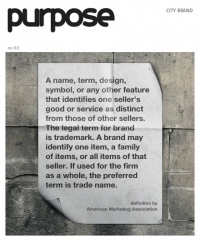
Article
From editors

Maciej Mazerant
The latest issue of „Purpose” magazine we have prepared under the influence of the discussion provoked around the brand strategy of Łódź created in the latest months. “The city brand” is such a current topic that each city, as well as a growing number of smaller towns in Poland and abroad take a decision to present its unique image to the world with hopes to create a competitive advantage. What then makes the cities of the global village differ from each other? Is there really any area determining the uniqueness of a given city or town? If so, how to prove it to the world?
We have asked those questions in several metropolises and to experts and people fascinated by the topic. Both those who earn from creating urban brand’s strategies and those who make use of it have been invited to express their opinions.On how controversial it is to spend six hundred thousand Polish zloty on creating the city brand strategy – that is how much Łódź paid for this – we have had a chance to find out while preparing the interview with Simon Anholt. The world-famous nation brands expert, the author of Anholt-GfK Roper Nation Brands Index™ and Anholt GfK-Roper City Brands Index™ says: „[…] forget about the brand-building. Conduct a decent and well-planned tourism promotion and make sure it’s at the real world level. However, reputation does not come from campaign but from a good, coherent, clever and aware management”. Maybe that is why the authors of the brand strategy of Łódź from Demo Effective Launching did not reply to our invitation concerning the presentation of experiences connected with the document preparation.
The conception of “Łódź – the city of creative industry” has became a starting point for the search of uniqueness of the city’s image. Of course we skipped such urban centers of creative industry like New York, London, Berlin or Los Angeles, and chose several cities in different continents which are not that popular.
Contact with the city authorities of Johannesburg turned out to be a great surprise. In this city there is particular emphasis placed on the development of creative sector – it contributes to the prevention of social and educational exclusion as well as job creation. About how the brand of the city has been created, along with the use of its creative potential, you can read in the interview with Matshidiso Mlaba, director of marketing in Public Liason Department in Johannesburg.
In creating the image of Polish city, cleanliness is its substantial problem. We turned to the Singapore’s authorities on this issue as the city is famous for the restrictive policy of keeping clean. Our questions were misunderstood. Mr. Muhd Hanafiah, director of Industry Department, and Carol Tan, director of National Marketing at Ministry of Information, Communications & the Arts made us feel the case was so obvious that even not worth deliberations. Our interlocutors were focused on presenting the significance of creative sector in the Singapore’s development and its image creation
While interviewing it turned out that Polish cities were not the only ones deprived of help of public authorities in the field of coherent promotional and image policy. As a result, the cities struggle on their own initiative for being noticed on the international area not usin
g the power given by the country brand. The cities of Australia battle against similar problem presented in the interview with Caroline Bergman, Project Manager of Building Brand Australia program. However, there is a fundamental difference between Australia and Poland; the first one has coherent national brand while in our country there are as many brands as ministries and other state-run institutions.
We turned to expert Paul Alezraa from the international company LORD that deals with cultural potential creation with a question of which of the European cities is worthy noticing and why. The cities of which the population did not exceed two hundred thousand were taken into consideration as we wanted to know whereas the development of the creative sector and brand building is possible in such places. The answer is in the article.
In the current issue of “Purpose” Polish accent could not have been omitted. In the section “In the margin” we present elaboration concerning creative sector in Szczecin prepared by Marcin Niewęgłowski, the main specialist of Szczecin 2016 Institution responsible for “The European Capital of Culture 2016” project. What is more, in “The feature” sector we present the text of Igor Gałązkiewicz, the art historian studying the relations of architecture, design and marketing, who introduces outstanding city brands and the order of activities that should have been taken to prevent the brand to be perceived as unreal sign and slogan only.
As always, you will find “The analysis” of Artur Zaguła in which the author questions brand creators and owners’ honesty advancing a brave thesis that “[…] The open market of competition-based products is starting to disappear”.
It seems like each city believes in the creative potential of its inhabitants nowadays. The majority of towns points at culture, creative sector, innovations and resourcefulness as essential factors of the image building. Then isn’t it too late for building the brand based on slogans exploited worldwide? How, among thousands of other “creative” cities, can we prove it is our city that should be distinguished? The task seems to be very difficult, especially when the city’s activity connected with the sector development does not underlie the image but the advertising slogans only.
Maciej Mazerant, the publisher of “Purpose”
Cover design: Tomasz Kaczkowski
Check the archive

no 63 February 2012
theme of the issue:
CITY BRAND
< spis treści
Article
From editors
Presentation
Montreal – creativity, originality and diversity
Career in Culture
Creativity centre - interview with Muhd Hanafiah - Agnieszka Furmańczyk
Culture Industries
Strong brand "phenomenon" - Paul Alezraa
On the Margin
Creative Szczecin, renewed - Marcin Niewęgłowski





